Analyzing the Role of Coaching Styles in Employee Personal Development
VerifiedAdded on 2020/03/01
|9
|2364
|145
Report
AI Summary
This report delves into the critical role of coaching in employee personal and professional development within the modern business environment. It investigates the effectiveness of various coaching styles, including democratic, career, performance, skills, life/personal, executive, and holistic coaching. The report explores the impact of each style on employee behavior, attitude, skills, and knowledge, ultimately affecting organizational performance. It highlights the importance of understanding coaching as a process for learning, development, and performance improvement. The report also discusses the research plan, emphasizing work shadowing and team facilitation as methods for evaluating coaching effectiveness. The conclusion underscores the significance of coaching in unlocking employee potential and driving lasting change, offering a valuable resource for leaders and organizations aiming to enhance employee capabilities and achieve sustainable success. The report is a comprehensive resource for students, offering insights into the dynamics of coaching and its impact on employee growth.
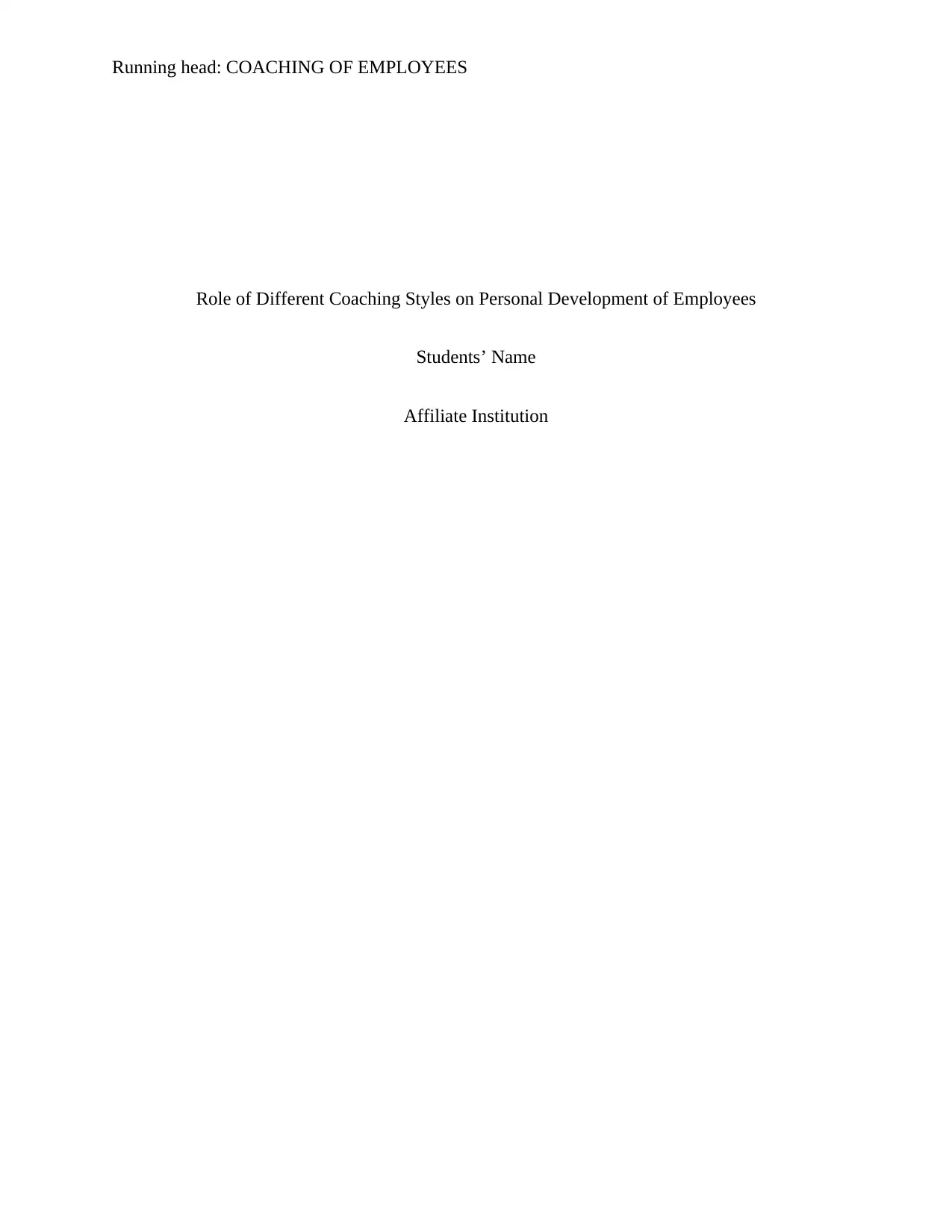
Running head: COACHING OF EMPLOYEES
Role of Different Coaching Styles on Personal Development of Employees
Students’ Name
Affiliate Institution
Role of Different Coaching Styles on Personal Development of Employees
Students’ Name
Affiliate Institution
Paraphrase This Document
Need a fresh take? Get an instant paraphrase of this document with our AI Paraphraser
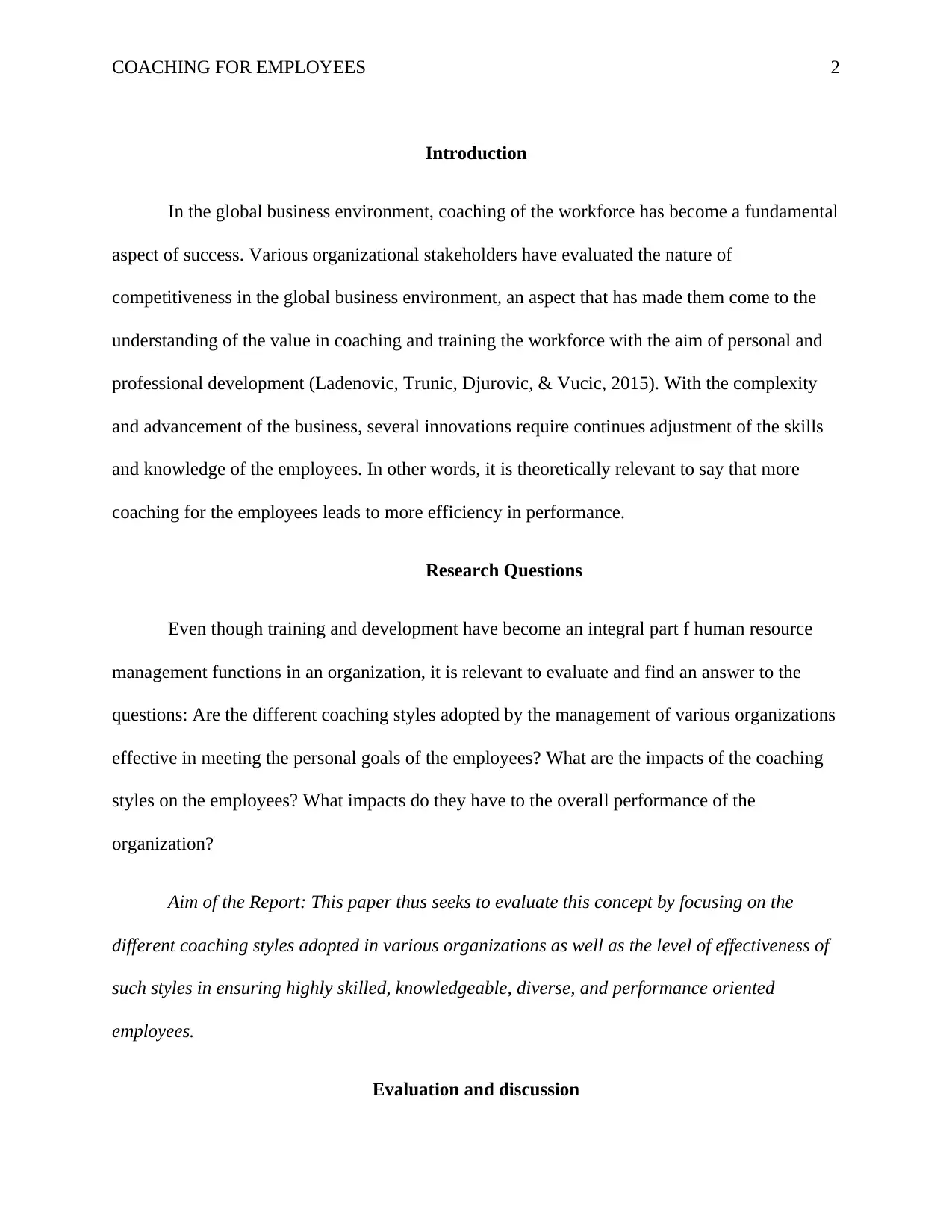
COACHING FOR EMPLOYEES 2
Introduction
In the global business environment, coaching of the workforce has become a fundamental
aspect of success. Various organizational stakeholders have evaluated the nature of
competitiveness in the global business environment, an aspect that has made them come to the
understanding of the value in coaching and training the workforce with the aim of personal and
professional development (Ladenovic, Trunic, Djurovic, & Vucic, 2015). With the complexity
and advancement of the business, several innovations require continues adjustment of the skills
and knowledge of the employees. In other words, it is theoretically relevant to say that more
coaching for the employees leads to more efficiency in performance.
Research Questions
Even though training and development have become an integral part f human resource
management functions in an organization, it is relevant to evaluate and find an answer to the
questions: Are the different coaching styles adopted by the management of various organizations
effective in meeting the personal goals of the employees? What are the impacts of the coaching
styles on the employees? What impacts do they have to the overall performance of the
organization?
Aim of the Report: This paper thus seeks to evaluate this concept by focusing on the
different coaching styles adopted in various organizations as well as the level of effectiveness of
such styles in ensuring highly skilled, knowledgeable, diverse, and performance oriented
employees.
Evaluation and discussion
Introduction
In the global business environment, coaching of the workforce has become a fundamental
aspect of success. Various organizational stakeholders have evaluated the nature of
competitiveness in the global business environment, an aspect that has made them come to the
understanding of the value in coaching and training the workforce with the aim of personal and
professional development (Ladenovic, Trunic, Djurovic, & Vucic, 2015). With the complexity
and advancement of the business, several innovations require continues adjustment of the skills
and knowledge of the employees. In other words, it is theoretically relevant to say that more
coaching for the employees leads to more efficiency in performance.
Research Questions
Even though training and development have become an integral part f human resource
management functions in an organization, it is relevant to evaluate and find an answer to the
questions: Are the different coaching styles adopted by the management of various organizations
effective in meeting the personal goals of the employees? What are the impacts of the coaching
styles on the employees? What impacts do they have to the overall performance of the
organization?
Aim of the Report: This paper thus seeks to evaluate this concept by focusing on the
different coaching styles adopted in various organizations as well as the level of effectiveness of
such styles in ensuring highly skilled, knowledgeable, diverse, and performance oriented
employees.
Evaluation and discussion
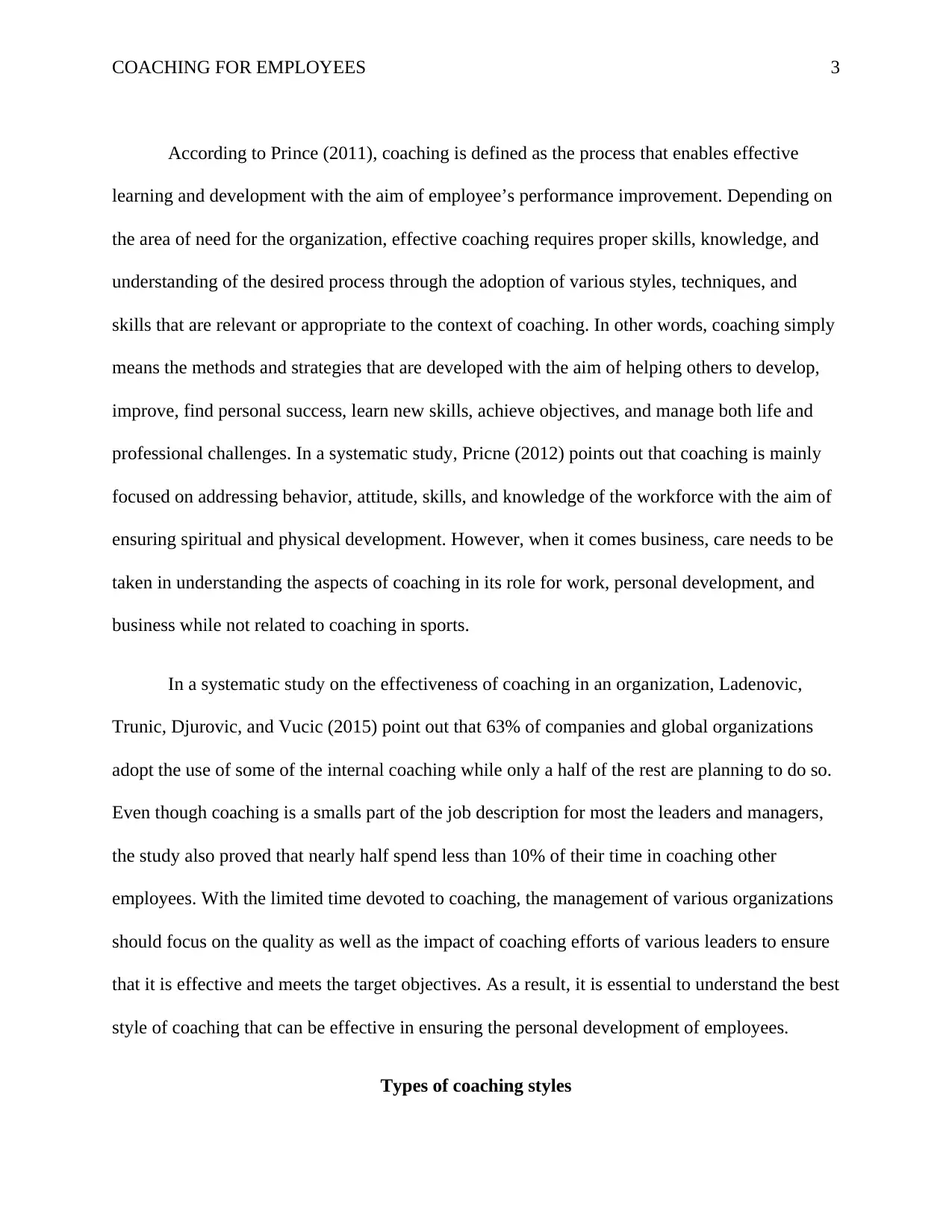
COACHING FOR EMPLOYEES 3
According to Prince (2011), coaching is defined as the process that enables effective
learning and development with the aim of employee’s performance improvement. Depending on
the area of need for the organization, effective coaching requires proper skills, knowledge, and
understanding of the desired process through the adoption of various styles, techniques, and
skills that are relevant or appropriate to the context of coaching. In other words, coaching simply
means the methods and strategies that are developed with the aim of helping others to develop,
improve, find personal success, learn new skills, achieve objectives, and manage both life and
professional challenges. In a systematic study, Pricne (2012) points out that coaching is mainly
focused on addressing behavior, attitude, skills, and knowledge of the workforce with the aim of
ensuring spiritual and physical development. However, when it comes business, care needs to be
taken in understanding the aspects of coaching in its role for work, personal development, and
business while not related to coaching in sports.
In a systematic study on the effectiveness of coaching in an organization, Ladenovic,
Trunic, Djurovic, and Vucic (2015) point out that 63% of companies and global organizations
adopt the use of some of the internal coaching while only a half of the rest are planning to do so.
Even though coaching is a smalls part of the job description for most the leaders and managers,
the study also proved that nearly half spend less than 10% of their time in coaching other
employees. With the limited time devoted to coaching, the management of various organizations
should focus on the quality as well as the impact of coaching efforts of various leaders to ensure
that it is effective and meets the target objectives. As a result, it is essential to understand the best
style of coaching that can be effective in ensuring the personal development of employees.
Types of coaching styles
According to Prince (2011), coaching is defined as the process that enables effective
learning and development with the aim of employee’s performance improvement. Depending on
the area of need for the organization, effective coaching requires proper skills, knowledge, and
understanding of the desired process through the adoption of various styles, techniques, and
skills that are relevant or appropriate to the context of coaching. In other words, coaching simply
means the methods and strategies that are developed with the aim of helping others to develop,
improve, find personal success, learn new skills, achieve objectives, and manage both life and
professional challenges. In a systematic study, Pricne (2012) points out that coaching is mainly
focused on addressing behavior, attitude, skills, and knowledge of the workforce with the aim of
ensuring spiritual and physical development. However, when it comes business, care needs to be
taken in understanding the aspects of coaching in its role for work, personal development, and
business while not related to coaching in sports.
In a systematic study on the effectiveness of coaching in an organization, Ladenovic,
Trunic, Djurovic, and Vucic (2015) point out that 63% of companies and global organizations
adopt the use of some of the internal coaching while only a half of the rest are planning to do so.
Even though coaching is a smalls part of the job description for most the leaders and managers,
the study also proved that nearly half spend less than 10% of their time in coaching other
employees. With the limited time devoted to coaching, the management of various organizations
should focus on the quality as well as the impact of coaching efforts of various leaders to ensure
that it is effective and meets the target objectives. As a result, it is essential to understand the best
style of coaching that can be effective in ensuring the personal development of employees.
Types of coaching styles
⊘ This is a preview!⊘
Do you want full access?
Subscribe today to unlock all pages.

Trusted by 1+ million students worldwide
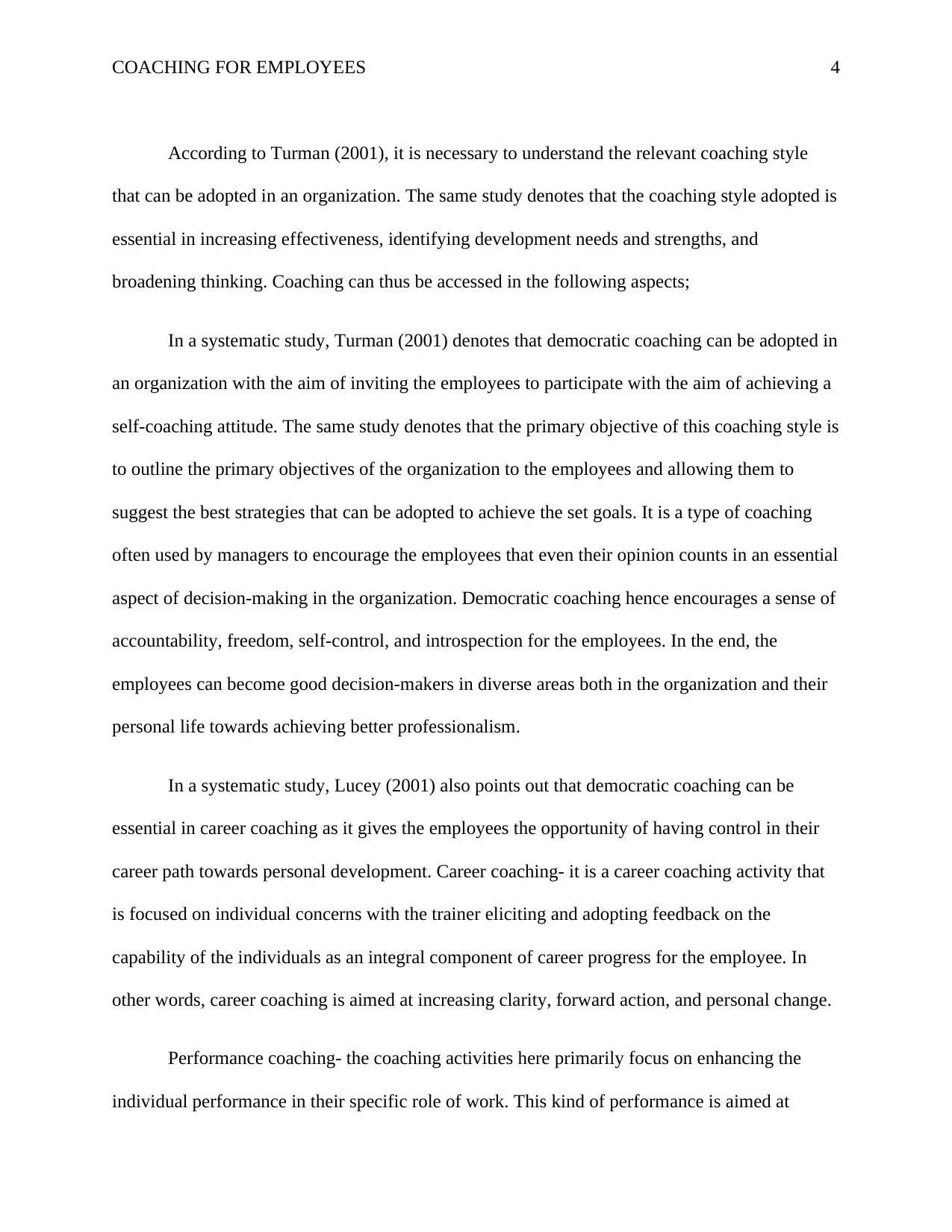
COACHING FOR EMPLOYEES 4
According to Turman (2001), it is necessary to understand the relevant coaching style
that can be adopted in an organization. The same study denotes that the coaching style adopted is
essential in increasing effectiveness, identifying development needs and strengths, and
broadening thinking. Coaching can thus be accessed in the following aspects;
In a systematic study, Turman (2001) denotes that democratic coaching can be adopted in
an organization with the aim of inviting the employees to participate with the aim of achieving a
self-coaching attitude. The same study denotes that the primary objective of this coaching style is
to outline the primary objectives of the organization to the employees and allowing them to
suggest the best strategies that can be adopted to achieve the set goals. It is a type of coaching
often used by managers to encourage the employees that even their opinion counts in an essential
aspect of decision-making in the organization. Democratic coaching hence encourages a sense of
accountability, freedom, self-control, and introspection for the employees. In the end, the
employees can become good decision-makers in diverse areas both in the organization and their
personal life towards achieving better professionalism.
In a systematic study, Lucey (2001) also points out that democratic coaching can be
essential in career coaching as it gives the employees the opportunity of having control in their
career path towards personal development. Career coaching- it is a career coaching activity that
is focused on individual concerns with the trainer eliciting and adopting feedback on the
capability of the individuals as an integral component of career progress for the employee. In
other words, career coaching is aimed at increasing clarity, forward action, and personal change.
Performance coaching- the coaching activities here primarily focus on enhancing the
individual performance in their specific role of work. This kind of performance is aimed at
According to Turman (2001), it is necessary to understand the relevant coaching style
that can be adopted in an organization. The same study denotes that the coaching style adopted is
essential in increasing effectiveness, identifying development needs and strengths, and
broadening thinking. Coaching can thus be accessed in the following aspects;
In a systematic study, Turman (2001) denotes that democratic coaching can be adopted in
an organization with the aim of inviting the employees to participate with the aim of achieving a
self-coaching attitude. The same study denotes that the primary objective of this coaching style is
to outline the primary objectives of the organization to the employees and allowing them to
suggest the best strategies that can be adopted to achieve the set goals. It is a type of coaching
often used by managers to encourage the employees that even their opinion counts in an essential
aspect of decision-making in the organization. Democratic coaching hence encourages a sense of
accountability, freedom, self-control, and introspection for the employees. In the end, the
employees can become good decision-makers in diverse areas both in the organization and their
personal life towards achieving better professionalism.
In a systematic study, Lucey (2001) also points out that democratic coaching can be
essential in career coaching as it gives the employees the opportunity of having control in their
career path towards personal development. Career coaching- it is a career coaching activity that
is focused on individual concerns with the trainer eliciting and adopting feedback on the
capability of the individuals as an integral component of career progress for the employee. In
other words, career coaching is aimed at increasing clarity, forward action, and personal change.
Performance coaching- the coaching activities here primarily focus on enhancing the
individual performance in their specific role of work. This kind of performance is aimed at
Paraphrase This Document
Need a fresh take? Get an instant paraphrase of this document with our AI Paraphraser
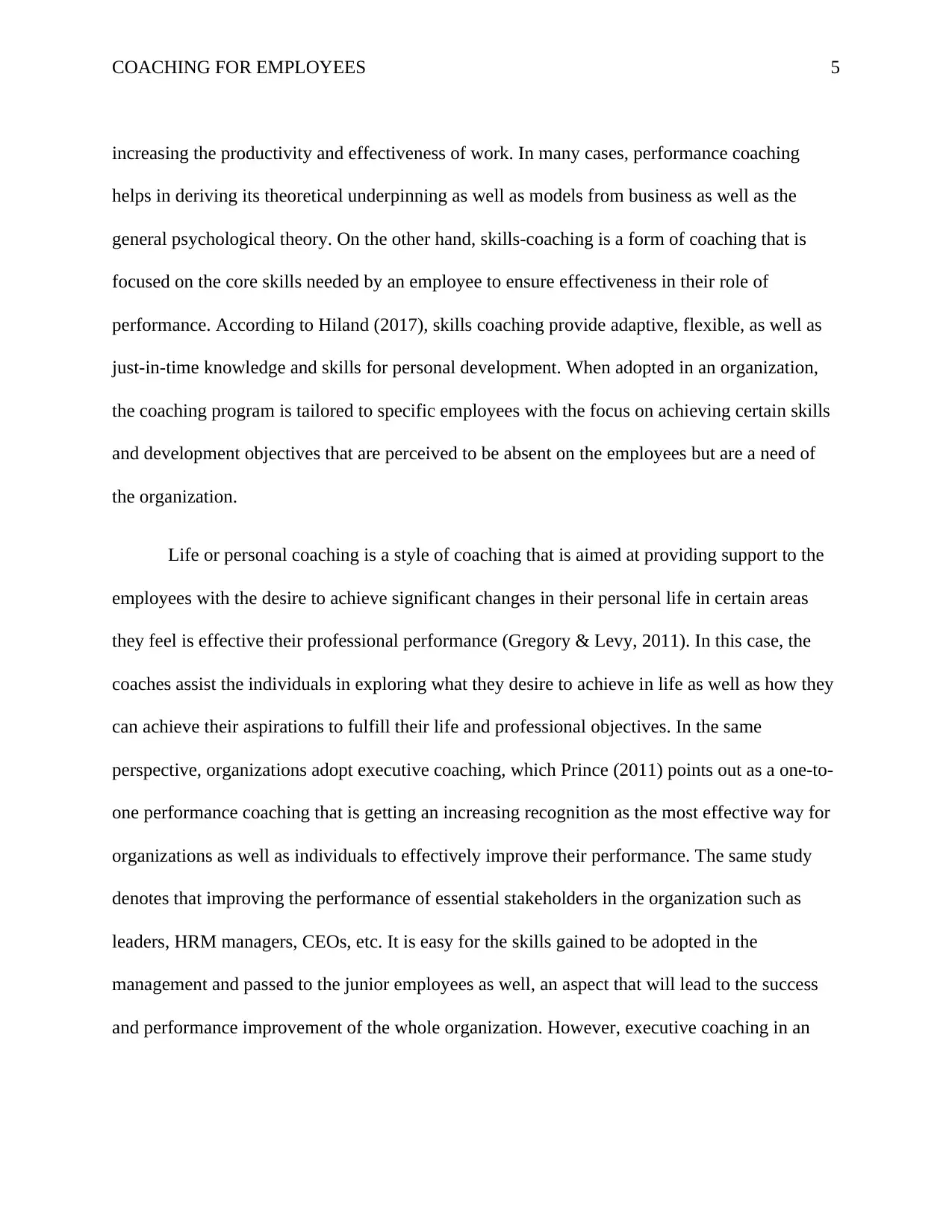
COACHING FOR EMPLOYEES 5
increasing the productivity and effectiveness of work. In many cases, performance coaching
helps in deriving its theoretical underpinning as well as models from business as well as the
general psychological theory. On the other hand, skills-coaching is a form of coaching that is
focused on the core skills needed by an employee to ensure effectiveness in their role of
performance. According to Hiland (2017), skills coaching provide adaptive, flexible, as well as
just-in-time knowledge and skills for personal development. When adopted in an organization,
the coaching program is tailored to specific employees with the focus on achieving certain skills
and development objectives that are perceived to be absent on the employees but are a need of
the organization.
Life or personal coaching is a style of coaching that is aimed at providing support to the
employees with the desire to achieve significant changes in their personal life in certain areas
they feel is effective their professional performance (Gregory & Levy, 2011). In this case, the
coaches assist the individuals in exploring what they desire to achieve in life as well as how they
can achieve their aspirations to fulfill their life and professional objectives. In the same
perspective, organizations adopt executive coaching, which Prince (2011) points out as a one-to-
one performance coaching that is getting an increasing recognition as the most effective way for
organizations as well as individuals to effectively improve their performance. The same study
denotes that improving the performance of essential stakeholders in the organization such as
leaders, HRM managers, CEOs, etc. It is easy for the skills gained to be adopted in the
management and passed to the junior employees as well, an aspect that will lead to the success
and performance improvement of the whole organization. However, executive coaching in an
increasing the productivity and effectiveness of work. In many cases, performance coaching
helps in deriving its theoretical underpinning as well as models from business as well as the
general psychological theory. On the other hand, skills-coaching is a form of coaching that is
focused on the core skills needed by an employee to ensure effectiveness in their role of
performance. According to Hiland (2017), skills coaching provide adaptive, flexible, as well as
just-in-time knowledge and skills for personal development. When adopted in an organization,
the coaching program is tailored to specific employees with the focus on achieving certain skills
and development objectives that are perceived to be absent on the employees but are a need of
the organization.
Life or personal coaching is a style of coaching that is aimed at providing support to the
employees with the desire to achieve significant changes in their personal life in certain areas
they feel is effective their professional performance (Gregory & Levy, 2011). In this case, the
coaches assist the individuals in exploring what they desire to achieve in life as well as how they
can achieve their aspirations to fulfill their life and professional objectives. In the same
perspective, organizations adopt executive coaching, which Prince (2011) points out as a one-to-
one performance coaching that is getting an increasing recognition as the most effective way for
organizations as well as individuals to effectively improve their performance. The same study
denotes that improving the performance of essential stakeholders in the organization such as
leaders, HRM managers, CEOs, etc. It is easy for the skills gained to be adopted in the
management and passed to the junior employees as well, an aspect that will lead to the success
and performance improvement of the whole organization. However, executive coaching in an
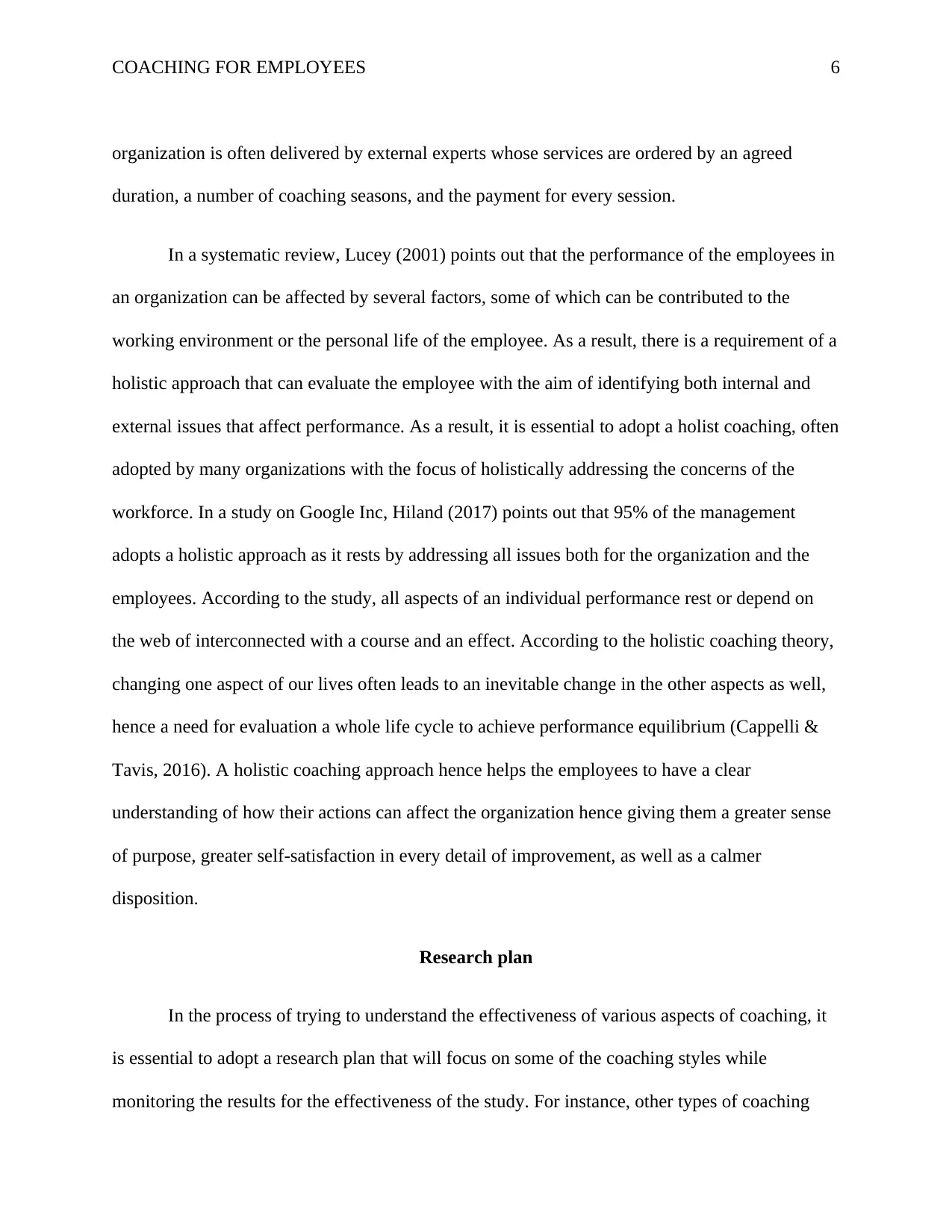
COACHING FOR EMPLOYEES 6
organization is often delivered by external experts whose services are ordered by an agreed
duration, a number of coaching seasons, and the payment for every session.
In a systematic review, Lucey (2001) points out that the performance of the employees in
an organization can be affected by several factors, some of which can be contributed to the
working environment or the personal life of the employee. As a result, there is a requirement of a
holistic approach that can evaluate the employee with the aim of identifying both internal and
external issues that affect performance. As a result, it is essential to adopt a holist coaching, often
adopted by many organizations with the focus of holistically addressing the concerns of the
workforce. In a study on Google Inc, Hiland (2017) points out that 95% of the management
adopts a holistic approach as it rests by addressing all issues both for the organization and the
employees. According to the study, all aspects of an individual performance rest or depend on
the web of interconnected with a course and an effect. According to the holistic coaching theory,
changing one aspect of our lives often leads to an inevitable change in the other aspects as well,
hence a need for evaluation a whole life cycle to achieve performance equilibrium (Cappelli &
Tavis, 2016). A holistic coaching approach hence helps the employees to have a clear
understanding of how their actions can affect the organization hence giving them a greater sense
of purpose, greater self-satisfaction in every detail of improvement, as well as a calmer
disposition.
Research plan
In the process of trying to understand the effectiveness of various aspects of coaching, it
is essential to adopt a research plan that will focus on some of the coaching styles while
monitoring the results for the effectiveness of the study. For instance, other types of coaching
organization is often delivered by external experts whose services are ordered by an agreed
duration, a number of coaching seasons, and the payment for every session.
In a systematic review, Lucey (2001) points out that the performance of the employees in
an organization can be affected by several factors, some of which can be contributed to the
working environment or the personal life of the employee. As a result, there is a requirement of a
holistic approach that can evaluate the employee with the aim of identifying both internal and
external issues that affect performance. As a result, it is essential to adopt a holist coaching, often
adopted by many organizations with the focus of holistically addressing the concerns of the
workforce. In a study on Google Inc, Hiland (2017) points out that 95% of the management
adopts a holistic approach as it rests by addressing all issues both for the organization and the
employees. According to the study, all aspects of an individual performance rest or depend on
the web of interconnected with a course and an effect. According to the holistic coaching theory,
changing one aspect of our lives often leads to an inevitable change in the other aspects as well,
hence a need for evaluation a whole life cycle to achieve performance equilibrium (Cappelli &
Tavis, 2016). A holistic coaching approach hence helps the employees to have a clear
understanding of how their actions can affect the organization hence giving them a greater sense
of purpose, greater self-satisfaction in every detail of improvement, as well as a calmer
disposition.
Research plan
In the process of trying to understand the effectiveness of various aspects of coaching, it
is essential to adopt a research plan that will focus on some of the coaching styles while
monitoring the results for the effectiveness of the study. For instance, other types of coaching
⊘ This is a preview!⊘
Do you want full access?
Subscribe today to unlock all pages.

Trusted by 1+ million students worldwide
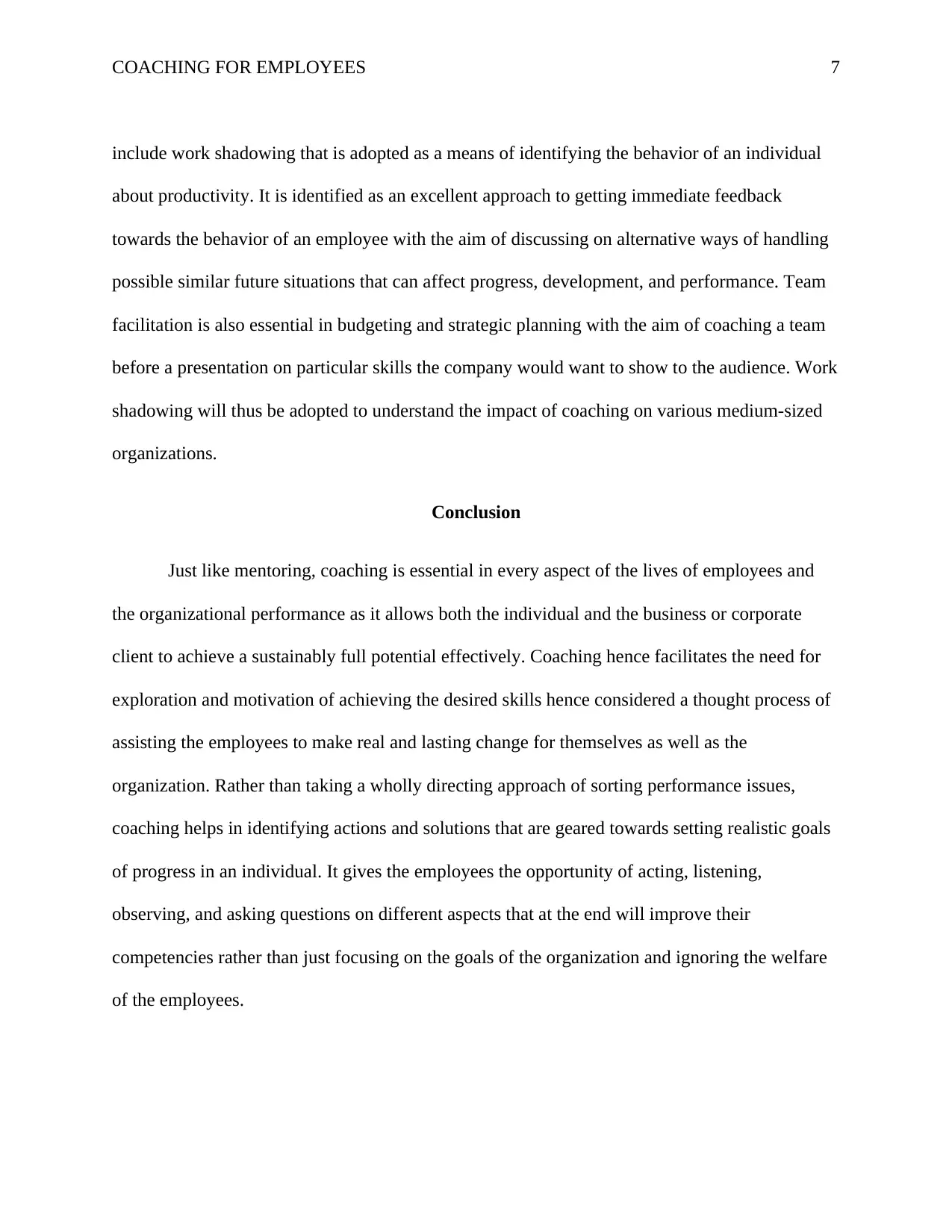
COACHING FOR EMPLOYEES 7
include work shadowing that is adopted as a means of identifying the behavior of an individual
about productivity. It is identified as an excellent approach to getting immediate feedback
towards the behavior of an employee with the aim of discussing on alternative ways of handling
possible similar future situations that can affect progress, development, and performance. Team
facilitation is also essential in budgeting and strategic planning with the aim of coaching a team
before a presentation on particular skills the company would want to show to the audience. Work
shadowing will thus be adopted to understand the impact of coaching on various medium-sized
organizations.
Conclusion
Just like mentoring, coaching is essential in every aspect of the lives of employees and
the organizational performance as it allows both the individual and the business or corporate
client to achieve a sustainably full potential effectively. Coaching hence facilitates the need for
exploration and motivation of achieving the desired skills hence considered a thought process of
assisting the employees to make real and lasting change for themselves as well as the
organization. Rather than taking a wholly directing approach of sorting performance issues,
coaching helps in identifying actions and solutions that are geared towards setting realistic goals
of progress in an individual. It gives the employees the opportunity of acting, listening,
observing, and asking questions on different aspects that at the end will improve their
competencies rather than just focusing on the goals of the organization and ignoring the welfare
of the employees.
include work shadowing that is adopted as a means of identifying the behavior of an individual
about productivity. It is identified as an excellent approach to getting immediate feedback
towards the behavior of an employee with the aim of discussing on alternative ways of handling
possible similar future situations that can affect progress, development, and performance. Team
facilitation is also essential in budgeting and strategic planning with the aim of coaching a team
before a presentation on particular skills the company would want to show to the audience. Work
shadowing will thus be adopted to understand the impact of coaching on various medium-sized
organizations.
Conclusion
Just like mentoring, coaching is essential in every aspect of the lives of employees and
the organizational performance as it allows both the individual and the business or corporate
client to achieve a sustainably full potential effectively. Coaching hence facilitates the need for
exploration and motivation of achieving the desired skills hence considered a thought process of
assisting the employees to make real and lasting change for themselves as well as the
organization. Rather than taking a wholly directing approach of sorting performance issues,
coaching helps in identifying actions and solutions that are geared towards setting realistic goals
of progress in an individual. It gives the employees the opportunity of acting, listening,
observing, and asking questions on different aspects that at the end will improve their
competencies rather than just focusing on the goals of the organization and ignoring the welfare
of the employees.
Paraphrase This Document
Need a fresh take? Get an instant paraphrase of this document with our AI Paraphraser
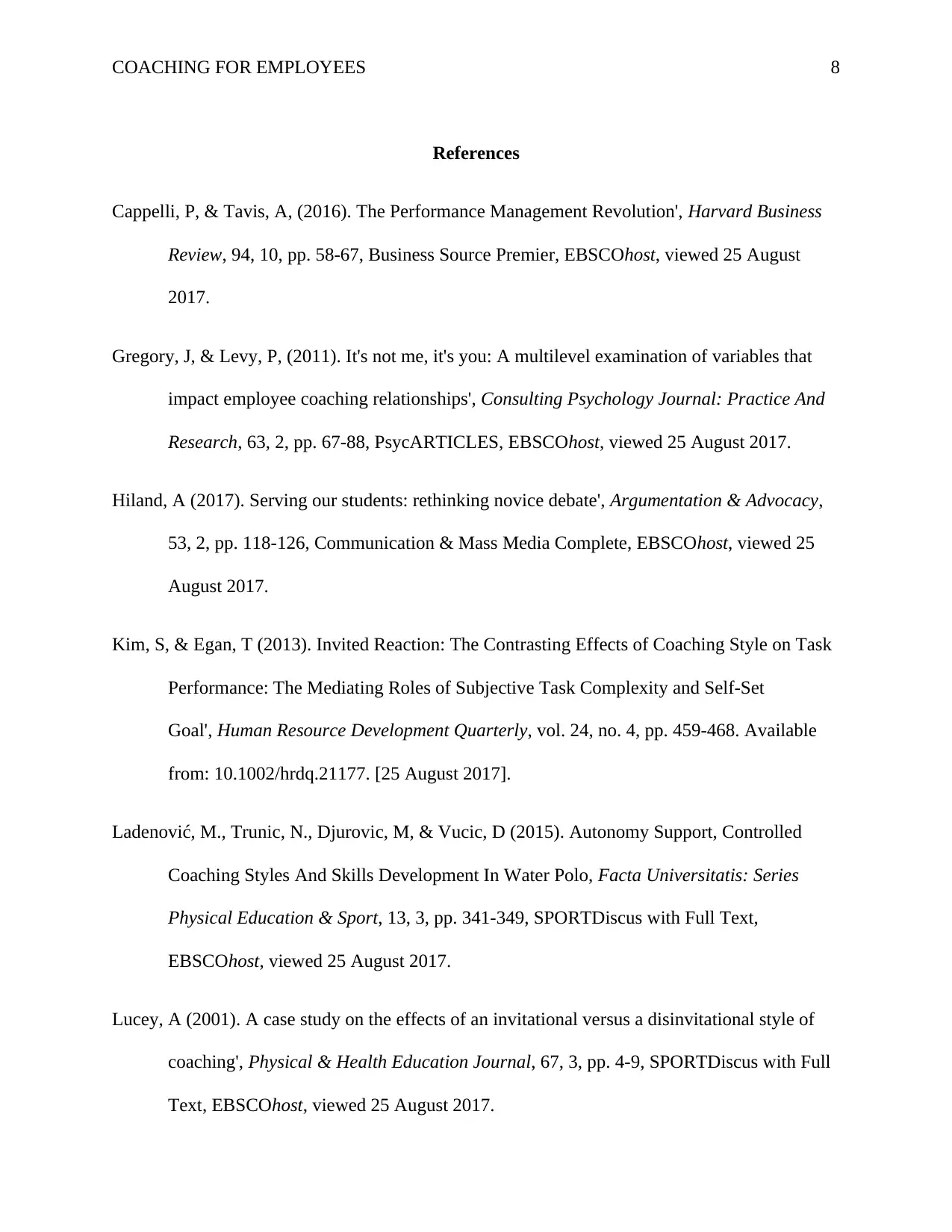
COACHING FOR EMPLOYEES 8
References
Cappelli, P, & Tavis, A, (2016). The Performance Management Revolution', Harvard Business
Review, 94, 10, pp. 58-67, Business Source Premier, EBSCOhost, viewed 25 August
2017.
Gregory, J, & Levy, P, (2011). It's not me, it's you: A multilevel examination of variables that
impact employee coaching relationships', Consulting Psychology Journal: Practice And
Research, 63, 2, pp. 67-88, PsycARTICLES, EBSCOhost, viewed 25 August 2017.
Hiland, A (2017). Serving our students: rethinking novice debate', Argumentation & Advocacy,
53, 2, pp. 118-126, Communication & Mass Media Complete, EBSCOhost, viewed 25
August 2017.
Kim, S, & Egan, T (2013). Invited Reaction: The Contrasting Effects of Coaching Style on Task
Performance: The Mediating Roles of Subjective Task Complexity and Self-Set
Goal', Human Resource Development Quarterly, vol. 24, no. 4, pp. 459-468. Available
from: 10.1002/hrdq.21177. [25 August 2017].
Ladenović, M., Trunic, N., Djurovic, M, & Vucic, D (2015). Autonomy Support, Controlled
Coaching Styles And Skills Development In Water Polo, Facta Universitatis: Series
Physical Education & Sport, 13, 3, pp. 341-349, SPORTDiscus with Full Text,
EBSCOhost, viewed 25 August 2017.
Lucey, A (2001). A case study on the effects of an invitational versus a disinvitational style of
coaching', Physical & Health Education Journal, 67, 3, pp. 4-9, SPORTDiscus with Full
Text, EBSCOhost, viewed 25 August 2017.
References
Cappelli, P, & Tavis, A, (2016). The Performance Management Revolution', Harvard Business
Review, 94, 10, pp. 58-67, Business Source Premier, EBSCOhost, viewed 25 August
2017.
Gregory, J, & Levy, P, (2011). It's not me, it's you: A multilevel examination of variables that
impact employee coaching relationships', Consulting Psychology Journal: Practice And
Research, 63, 2, pp. 67-88, PsycARTICLES, EBSCOhost, viewed 25 August 2017.
Hiland, A (2017). Serving our students: rethinking novice debate', Argumentation & Advocacy,
53, 2, pp. 118-126, Communication & Mass Media Complete, EBSCOhost, viewed 25
August 2017.
Kim, S, & Egan, T (2013). Invited Reaction: The Contrasting Effects of Coaching Style on Task
Performance: The Mediating Roles of Subjective Task Complexity and Self-Set
Goal', Human Resource Development Quarterly, vol. 24, no. 4, pp. 459-468. Available
from: 10.1002/hrdq.21177. [25 August 2017].
Ladenović, M., Trunic, N., Djurovic, M, & Vucic, D (2015). Autonomy Support, Controlled
Coaching Styles And Skills Development In Water Polo, Facta Universitatis: Series
Physical Education & Sport, 13, 3, pp. 341-349, SPORTDiscus with Full Text,
EBSCOhost, viewed 25 August 2017.
Lucey, A (2001). A case study on the effects of an invitational versus a disinvitational style of
coaching', Physical & Health Education Journal, 67, 3, pp. 4-9, SPORTDiscus with Full
Text, EBSCOhost, viewed 25 August 2017.
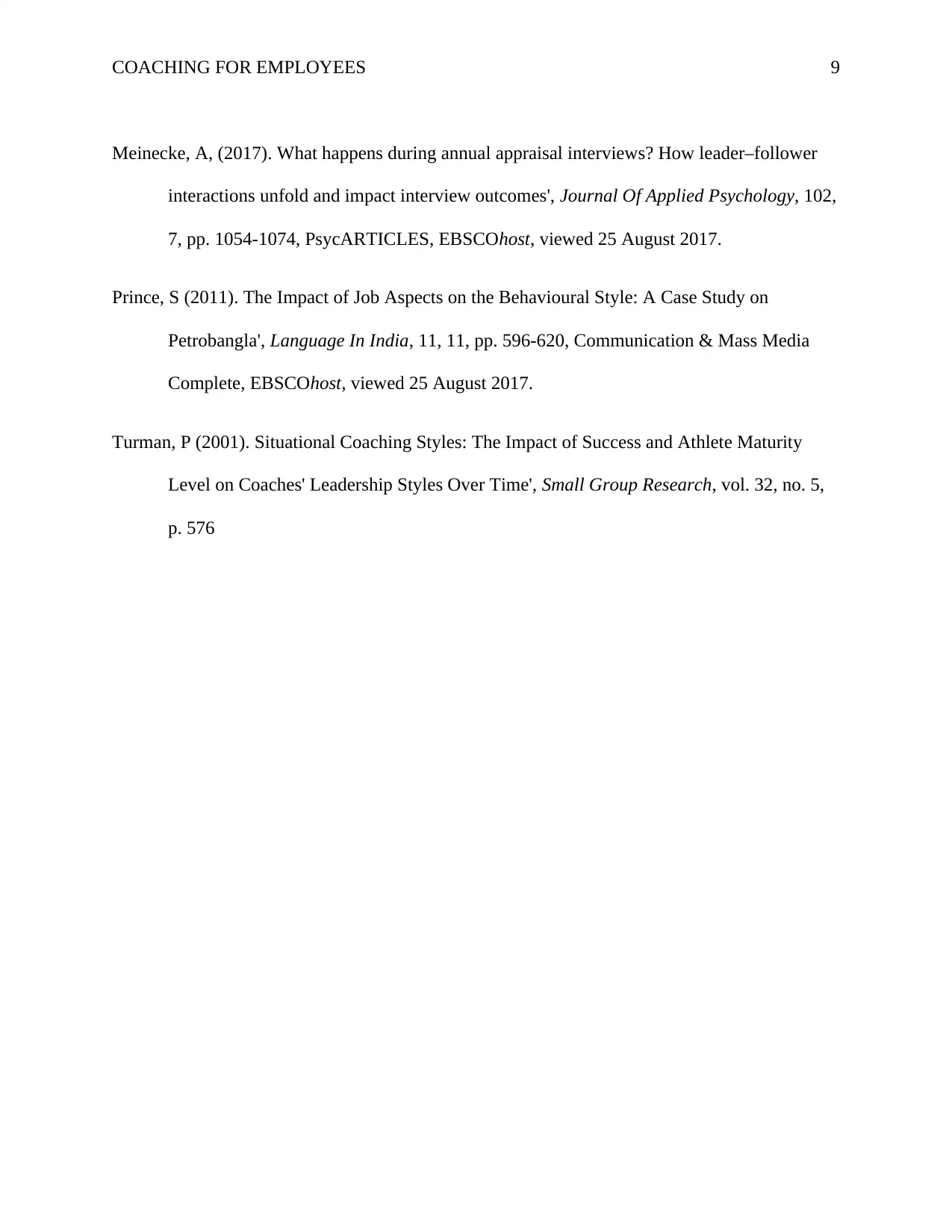
COACHING FOR EMPLOYEES 9
Meinecke, A, (2017). What happens during annual appraisal interviews? How leader–follower
interactions unfold and impact interview outcomes', Journal Of Applied Psychology, 102,
7, pp. 1054-1074, PsycARTICLES, EBSCOhost, viewed 25 August 2017.
Prince, S (2011). The Impact of Job Aspects on the Behavioural Style: A Case Study on
Petrobangla', Language In India, 11, 11, pp. 596-620, Communication & Mass Media
Complete, EBSCOhost, viewed 25 August 2017.
Turman, P (2001). Situational Coaching Styles: The Impact of Success and Athlete Maturity
Level on Coaches' Leadership Styles Over Time', Small Group Research, vol. 32, no. 5,
p. 576
Meinecke, A, (2017). What happens during annual appraisal interviews? How leader–follower
interactions unfold and impact interview outcomes', Journal Of Applied Psychology, 102,
7, pp. 1054-1074, PsycARTICLES, EBSCOhost, viewed 25 August 2017.
Prince, S (2011). The Impact of Job Aspects on the Behavioural Style: A Case Study on
Petrobangla', Language In India, 11, 11, pp. 596-620, Communication & Mass Media
Complete, EBSCOhost, viewed 25 August 2017.
Turman, P (2001). Situational Coaching Styles: The Impact of Success and Athlete Maturity
Level on Coaches' Leadership Styles Over Time', Small Group Research, vol. 32, no. 5,
p. 576
⊘ This is a preview!⊘
Do you want full access?
Subscribe today to unlock all pages.

Trusted by 1+ million students worldwide
1 out of 9
Related Documents
Your All-in-One AI-Powered Toolkit for Academic Success.
+13062052269
info@desklib.com
Available 24*7 on WhatsApp / Email
![[object Object]](/_next/static/media/star-bottom.7253800d.svg)
Unlock your academic potential
Copyright © 2020–2025 A2Z Services. All Rights Reserved. Developed and managed by ZUCOL.




